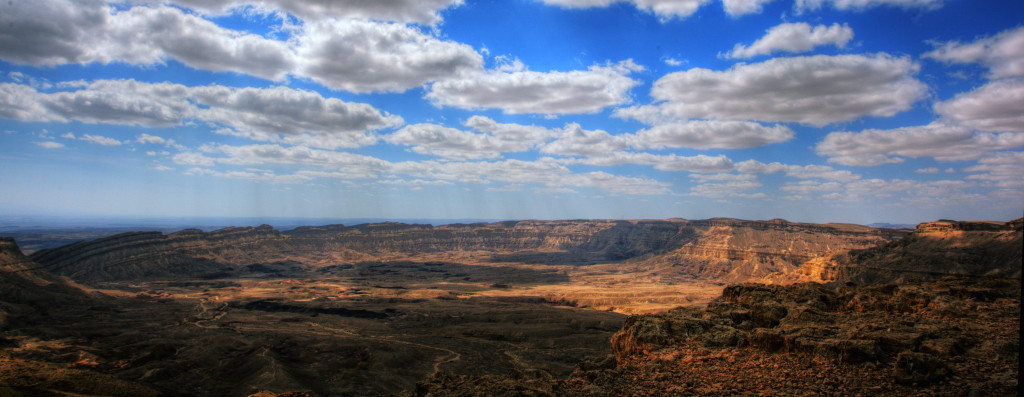Ramon Crater Lookout
December 16th 2014
 Ramon Crater, called Makhtesh Ramon in Hebrew, is Israel’s answer the Grand Canyon, although strictly speaking, it isn’t a proper canyon or even a crater! It’s a makhtesh, a geological landform exclusive to the Negev that scientists believe was created through erosion. The Ramon Crater is the largest makhtesh in Israel. Located 53 miles south of Beersheva in the midst of the Negev desert, the Ramon Crater is 25 miles long and 6 miles wide at its widest point. The crater is nearly 2,000 feet deep. Along its ridges are imposing mountains, including Har Ramon at the southern end of the heart-shaped crater and Har Ardon to the northeast.
Ramon Crater, called Makhtesh Ramon in Hebrew, is Israel’s answer the Grand Canyon, although strictly speaking, it isn’t a proper canyon or even a crater! It’s a makhtesh, a geological landform exclusive to the Negev that scientists believe was created through erosion. The Ramon Crater is the largest makhtesh in Israel. Located 53 miles south of Beersheva in the midst of the Negev desert, the Ramon Crater is 25 miles long and 6 miles wide at its widest point. The crater is nearly 2,000 feet deep. Along its ridges are imposing mountains, including Har Ramon at the southern end of the heart-shaped crater and Har Ardon to the northeast.
The entire crater and the mountains that surround it comprise the Ramon Nature Reserve, the largest natural park in Israel. The small town of Mitzpe Ramon, located just to the north of the Ramon Crater, is the only community in the area, and the views from here are jaw-droppingly amazing. Mitzpe Ramon offers a number of tourist services for visitors, including hotels, hostels, campsites and a Bedouin Inn. From here, one can hire a jeep, bicycle or camel tour. Tours through the Ramon Crater make it possible to see the desert wildlife and plants up close. A knowledgeable tour guide will be able to keep you away from the area when there is a danger of flash flooding. For the truly adventurous, rappelling down the sides of the crater can be arranged, with experiences originating at Mitzpe Ramon.
The Visitors’ Center is perched at the edge of the crater, offering amazing vistas. The official museum helps explain the natural and geological history of the area, including an explanation of how the makhtesh was originally formed. The Albert Promenade begins at the Visitors’ Center and continues along the edge of the Ramon Crater. The most scenic lookout, known as the bird balcony because birds fly below rather than above, is halfway across the promenade.
The crater itself can take hours or even days to explore. It offers hiking paths with various levels of difficulty, sites of historical interest, red and yellow clay hills, dry river beds, black prismatic rocks and many other geological wonders. The Ramon Crater is an ideal place to let the complex beauty of the desert work its magic on you.











